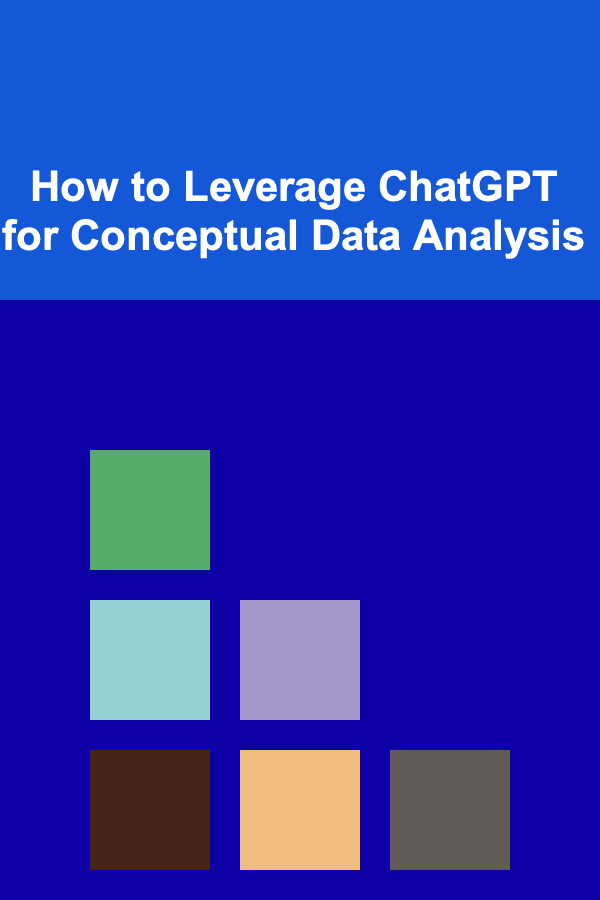
How to Leverage ChatGPT for Conceptual Data Analysis
ebook include PDF & Audio bundle (Micro Guide)
$12.99$6.99
Limited Time Offer! Order within the next:

In the world of data analysis, one of the biggest challenges is transforming raw data into actionable insights. While traditional data analysis tools focus on mathematical models, algorithms, and visualizations, the conceptual side of data --- understanding, interpreting, and synthesizing ideas --- often takes a backseat. However, recent advancements in artificial intelligence (AI), particularly language models like ChatGPT, have created a new opportunity to enhance how we approach conceptual data analysis.
This article delves into how ChatGPT can be leveraged for conceptual data analysis, from helping with data exploration to providing insights on data interpretation and communication. By utilizing ChatGPT's capabilities, analysts and decision-makers can enrich their analyses and engage in a deeper, more nuanced understanding of data.
Introduction to Conceptual Data Analysis
Conceptual data analysis involves interpreting the broader meanings, patterns, and implications hidden within the data. Unlike traditional statistical or computational approaches that focus primarily on numeric relationships and structures, conceptual data analysis focuses on:
- Understanding the context of the data.
- Identifying themes and patterns.
- Extracting qualitative insights from quantitative data.
- Creating narratives that reflect the underlying trends and insights.
In traditional data science workflows, this phase of analysis might be overlooked or relegated to domain experts. However, with the growing complexity of data and the need for human-centered analysis, conceptual data analysis is gaining prominence. This is where ChatGPT comes into play.
The Role of ChatGPT in Conceptual Data Analysis
ChatGPT is a powerful language model developed by OpenAI that can perform a variety of tasks, including natural language processing, summarization, and content generation. With the ability to process and interpret text, ChatGPT can assist in many aspects of conceptual data analysis. Let's explore how ChatGPT can support various stages of the conceptual data analysis process.
2.1. Data Exploration and Understanding
The first step in any data analysis process is exploration. Understanding the structure of the data, its variables, and its potential implications is crucial for making informed decisions later. ChatGPT can aid this stage by providing:
- Descriptive Summaries: ChatGPT can process and summarize large datasets, providing a high-level overview of key variables, distributions, and potential relationships.
- Contextual Understanding: ChatGPT can help interpret the meaning of specific variables, categories, or outliers, by processing metadata or previous research documents that explain the context behind the data.
- Automated Data Annotation: For datasets that require categorization or tagging, ChatGPT can automate the annotation process by identifying relevant terms and categorizing the data accordingly.
By offering context and insightful summaries, ChatGPT makes it easier for analysts to understand the broader implications of their datasets.
2.2. Identifying Themes and Patterns
Once the data has been explored, the next step is to identify themes and patterns. Traditional methods like clustering or classification can be helpful, but ChatGPT offers an additional layer of analysis through its ability to:
- Content Generation: ChatGPT can help generate hypotheses or potential themes based on text-based datasets, such as customer reviews or social media posts.
- Pattern Recognition: By processing natural language patterns, ChatGPT can highlight recurring topics, sentiments, or keywords that might be indicative of underlying trends in the data.
- Thematic Analysis: In qualitative data analysis, ChatGPT can perform thematic analysis by identifying common themes across large volumes of unstructured text data. This process can provide deeper insights into the underlying factors that influence the data.
By leveraging these capabilities, ChatGPT can assist analysts in uncovering subtle and complex patterns that might not be easily visible through traditional statistical techniques.
2.3. Data Interpretation
Data interpretation is where conceptual analysis truly comes to the forefront. It's about making sense of the data in ways that go beyond simple calculations. This is where ChatGPT shines in its ability to:
- Provide Explanations: ChatGPT can translate technical jargon and complex statistical results into layman-friendly language, making it easier for non-technical stakeholders to understand.
- Suggest Insights: Based on the data, ChatGPT can suggest potential insights or implications, helping analysts interpret data in a broader context.
- Generate Narratives: One of the most significant advantages of ChatGPT is its ability to generate narratives. It can create stories or explanations around data points, turning a raw dataset into a coherent and persuasive story.
Incorporating these narrative-driven insights into the data analysis process allows for a richer, more holistic understanding of the data.
2.4. Enhancing Data Visualization and Communication
Once the data is analyzed and interpreted, the next challenge is communication. Conceptual data analysis requires effective communication to convey the insights to stakeholders, decision-makers, or the public. ChatGPT can be an invaluable tool in this stage by:
- Generating Reports: ChatGPT can automatically generate comprehensive reports that summarize the analysis, providing context, findings, and recommendations in an easily understandable format.
- Creating Presentations: ChatGPT can help design presentation slides by summarizing key points, suggesting visuals, and even drafting speech notes for presenting the findings.
- Explaining Visualizations: ChatGPT can assist in writing clear and insightful captions or annotations for data visualizations, ensuring that the audience fully understands the significance of the charts, graphs, or tables.
By improving the clarity and effectiveness of communication, ChatGPT ensures that the insights derived from the data are accessible and actionable.
Practical Applications of ChatGPT in Conceptual Data Analysis
Now that we've outlined the ways in which ChatGPT can support conceptual data analysis, let's explore some practical applications across various industries.
3.1. Market Research
In market research, conceptual data analysis plays a vital role in understanding consumer behavior, preferences, and trends. ChatGPT can assist in:
- Analyzing customer feedback, reviews, and survey responses to identify emerging themes or sentiments.
- Generating insights from sales data, highlighting potential correlations between product features and consumer preferences.
- Offering context to market data, such as interpreting seasonal trends or identifying potential gaps in the market based on qualitative analysis.
These capabilities can help marketers create targeted campaigns, improve customer experiences, and drive business growth.
3.2. Healthcare
In healthcare, data analysis often goes beyond numbers. Researchers and practitioners need to interpret patient outcomes, clinical trial results, and epidemiological trends in a meaningful way. ChatGPT can be used for:
- Analyzing patient feedback from surveys and reviews to identify common concerns or sentiments.
- Interpreting complex clinical data and presenting it in a way that's accessible to healthcare professionals.
- Generating reports that synthesize findings from various clinical trials or research studies, providing insights into new treatments or care strategies.
ChatGPT's ability to understand medical terminology and context makes it an ideal tool for conceptual analysis in healthcare.
3.3. Education
In educational settings, data analysis often focuses on student performance, engagement, and learning outcomes. ChatGPT can support educators by:
- Analyzing student feedback and assessment data to identify common learning obstacles or trends.
- Providing explanations of complex educational theories or research findings in simpler terms.
- Creating personalized feedback for students based on their performance data, enhancing the learning experience.
By helping educators interpret data in a way that prioritizes student needs, ChatGPT can contribute to more effective teaching strategies and improved student outcomes.
3.4. Social Media and Sentiment Analysis
Social media platforms generate vast amounts of unstructured data that can be challenging to analyze. ChatGPT excels in conceptual analysis of social media data, where it can:
- Perform sentiment analysis on posts, comments, and tweets, identifying emotional tones and potential shifts in public opinion.
- Uncover underlying themes in social media conversations, such as concerns about a brand, product, or political issue.
- Generate summaries of trending topics or discussions, helping businesses or policymakers stay ahead of public sentiment.
By leveraging ChatGPT's natural language processing capabilities, social media analysts can gain valuable insights into public perceptions and attitudes.
Challenges and Limitations of Using ChatGPT for Conceptual Data Analysis
While ChatGPT offers many benefits for conceptual data analysis, there are also some challenges and limitations to consider:
- Data Privacy: Since ChatGPT is cloud-based, using it for sensitive or private data analysis requires careful consideration of data privacy regulations.
- Context Sensitivity: Although ChatGPT is highly advanced, it may not always fully grasp the context of certain specialized or domain-specific data. Additional input from domain experts may be necessary to refine the analysis.
- Interpretation Quality: While ChatGPT can generate insightful interpretations, its suggestions should always be verified by human analysts, as the model may occasionally miss nuances or offer less relevant insights.
Despite these challenges, when used effectively and with proper safeguards, ChatGPT can greatly enhance conceptual data analysis.
Conclusion
ChatGPT is a powerful tool that can transform the way we approach conceptual data analysis. By offering support in data exploration, pattern recognition, interpretation, and communication, it empowers analysts to gain deeper insights from their data. In industries ranging from market research to healthcare and education, the use of AI for conceptual data analysis is already showing tremendous promise.
As AI continues to evolve, the possibilities for leveraging models like ChatGPT in data analysis will only expand. By combining traditional analytical methods with AI-driven conceptual insights, businesses, researchers, and decision-makers can achieve a more comprehensive understanding of their data, ultimately leading to better-informed decisions and improved outcomes.

How to Build an Email List for Your Online Training Business
Read More
How to Choose Sustainable Materials for Your Home Renovation
Read More
How to Create a Moving Checklist for First-Time Movers
Read More
How To Optimize Your Brain for Memory Recall
Read More
How to Organize Your Bathroom with Limited Cabinet Space
Read More
Mastering the Future of Innovation
Read MoreOther Products

How to Build an Email List for Your Online Training Business
Read More
How to Choose Sustainable Materials for Your Home Renovation
Read More
How to Create a Moving Checklist for First-Time Movers
Read More
How To Optimize Your Brain for Memory Recall
Read More
How to Organize Your Bathroom with Limited Cabinet Space
Read More